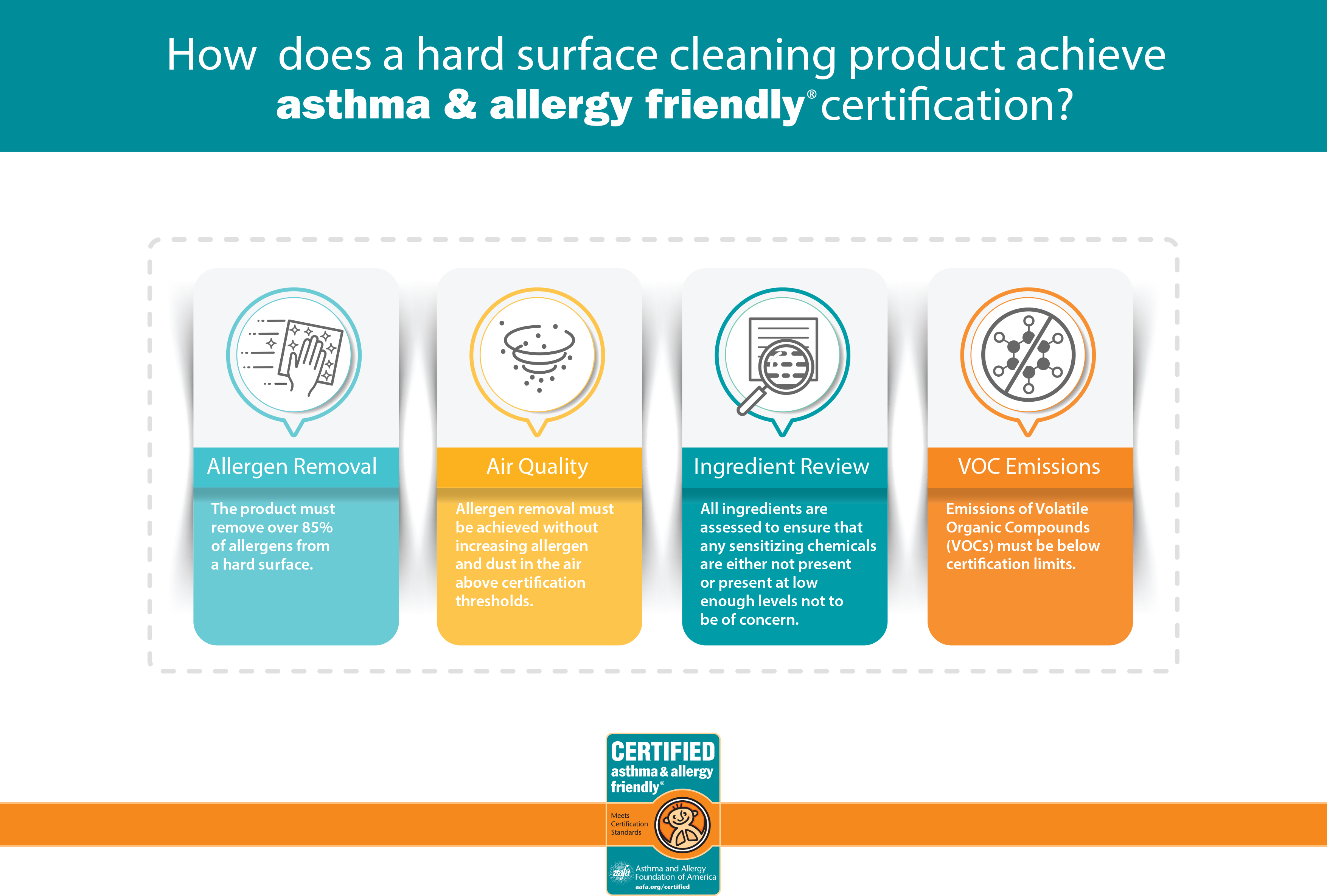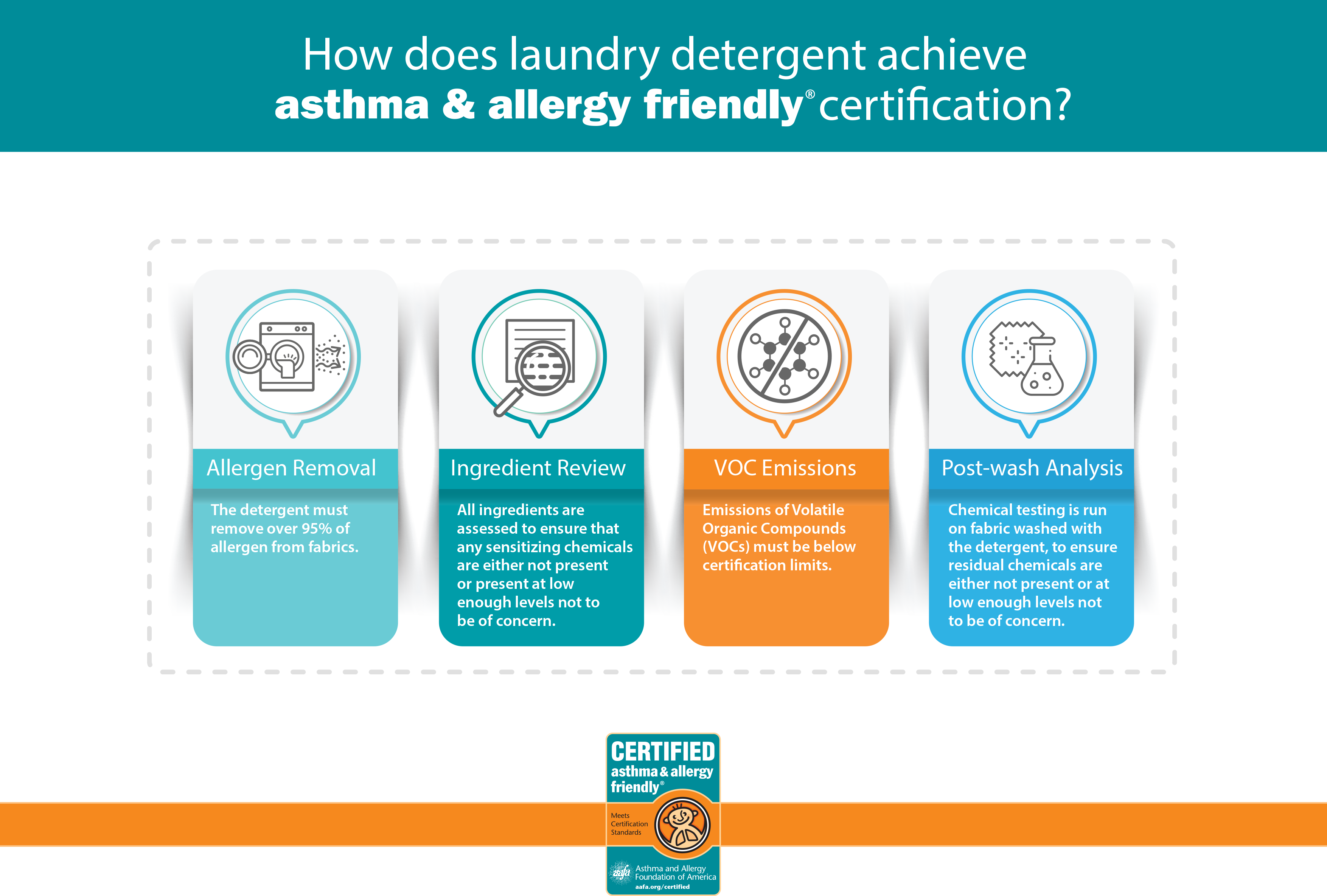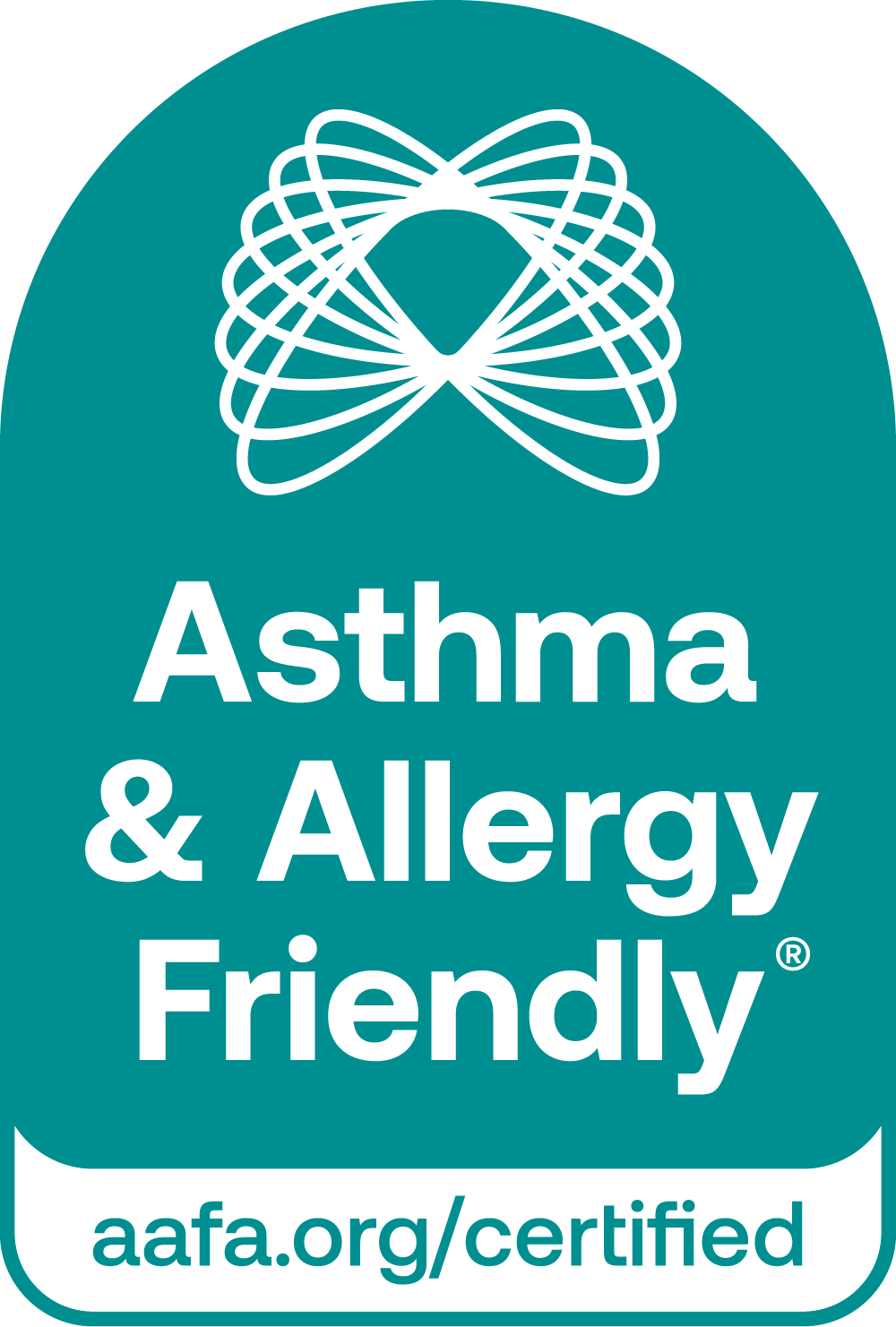Choosing Asthma & Allergy Friendly® Certified cleaning products and maintaining effective cleaning routines can significantly improve indoor air quality, helping to reduce allergens and harmful chemicals for a healthier home environment, especially for those with asthma or allergies.
As we celebrate Indoor Air Quality (IAQ) Awareness Month this October, it’s important to understand how our choice of cleaning products can impact the air we breathe. While many households focus on cleaning to reduce germs, few realize that certain cleaning products can also release potentially harmful chemicals or redistribute allergens into the air. This can have a direct impact on IAQ and, consequently, on the health of everyone in the home—especially those with asthma or allergies. By making informed choices and opting for Asthma & Allergy Friendly® Certified products, you can improve the cleanliness of your home without compromising air quality.
In this article, we’ll explore we’ll explore how effective cleaning routines and products can impact indoor air quality, and why choosing Asthma & Allergy Friendly® Certified products can help create a healthier indoor environment.
Why Indoor Air Quality Matters for Health
We spend the majority of our time indoors, making the quality of the air we breathe at home crucial to our health. Poor IAQ can be caused by allergens like dust mite allergen, pet dander, and pollen, as well as chemicals from cleaning products. For those with asthma or allergies, exposure to these airborne pollutants can trigger symptoms such as coughing, sneezing, and difficulty breathing. However, even for those without respiratory conditions, long-term exposure to poor IAQ can lead to issues like headaches, fatigue, and more serious respiratory conditions.
Reducing allergens and avoiding exposure to harmful chemicals in cleaning products can improve indoor air quality and create a healthier environment for everyone in the home. Choosing products that been independently tested and validated is an effective way to ensure you’re making choices that support better IAQ.
How Effective Cleaning Routines Affect Indoor Air Quality
Maintaining a regular cleaning routine is essential for improving indoor air quality, as it helps eliminate dirt, dust, and allergens that accumulate on surfaces. Cleaning for health and hygiene, rather than just for appearance, has become increasingly recognized as vital. Regular dusting with a moist cloth effectively removes dust and allergens from hard surfaces without simply redistributing them into the air.
Vacuuming, especially with a vacuum cleaner equipped with a validated high-efficiency particulate air (HEPA) filter, is paramount in reducing allergens like dust mite allergen, pet dander, and pollen from floors and carpets.
Ensuring proper ventilation during and after cleaning by opening windows is also important, and following the manufacturer’s instructions for cleaning products helps avoid the release of harmful pollutants from chemical reactions.
In addition to regular cleaning, preventing mold growth is crucial for maintaining good indoor air quality. Mold can thrive in damp environments, making it essential to remove any mold-damaged materials and thoroughly clean areas affected by mold.
Reducing clutter is another important step, as clutter can harbor dust and allergens, making cleaning more difficult and allowing particles to become airborne. By decluttering and organizing your space, you make it easier to clean effectively and reduce potential allergens in your home.
How Cleaning Products Affect Indoor Air Quality
Cleaning products can impact IAQ in two main ways: through the removal or redistribution of allergens and through the release of chemicals, particularly volatile organic compounds (VOCs).
Allergen Removal: Cleaning products play a crucial role in removing allergens from surfaces like countertops, floors, and fabrics. Effective products capture and remove allergens without sending them back into the air.
Chemical Emissions: Many cleaning products release VOCs into the air, which can contribute to poor indoor air quality. VOCs are chemicals that easily become gases and can lead to both short and long-term health effects.
Hard Surface Cleaning Products
Hard surface cleaning products are commonly used to clean areas such as kitchen counters, bathrooms, and floors. However, not all cleaning products are created equal in terms of their impact on IAQ. The Asthma & Allergy Friendly® Certification Program certifies hard surface cleaning products that meet stringent standards to ensure they are a more suitable choice for those with asthma and allergies, making them also a wise choice for better indoor air for the whole family.

To achieve Asthma & Allergy Friendly® Certification, hard surface cleaning products must meet the following criteria:
- Allergen Removal: The product must remove over 85% of allergens from hard surfaces, ensuring that allergens like dust mite debris, pet dander, and pollen are effectively removed.
- Air Quality: The product must clean surfaces without increasing the amount of allergen and dust in the air above certification thresholds, ensuring that allergens are removed rather than redistributed.
- Ingredient Review: All ingredients in the product are reviewed to ensure that any sensitizing chemicals are either not present or present at levels low enough not to cause concern.
- VOC Emissions: The product’s VOC emissions must be below the certification limits, ensuring minimal impact on IAQ.
By choosing a Certified Asthma & Allergy Friendly® hard surface cleaning product, you can have peace of mind knowing that the product has been rigorously tested for both allergen removal and chemical levels.
Laundry Detergents
Laundry detergents also play a crucial role in indoor air quality, especially as fabrics can trap allergens like dust mite allergen and pet dander. The Asthma & Allergy Friendly® Certification Program subjects laundry detergents to biological, physical, and chemical testing to ensure they are effective in reducing allergens without contributing to poor IAQ.

Certified laundry detergents are tested for the following:
- Allergen and Dust Removal: Laundry detergents are assessed for their ability to remove allergens from fabrics. This involves testing fabrics seeded with allergen-containing dust and comparing them to unwashed controls to ensure significant allergen reduction post-washing.
- Ingredient Review: The chemicals used in the laundry detergent are carefully reviewed to ensure they are non-sensitizing and non-allergenic.
- VOC Emissions: Laundry detergents are tested in an environmentally controlled chamber to measure the VOCs released over a 14-day period. Certification requires VOC levels to remain below strict certification limits.
- Post-wash Analysis: After washing, the levels of any residual allergenic, irritant, or banned chemicals left on the fabric must be either not present or at low enough levels not to be of concern.
Handheld Dusting Products and Wipes
Handheld dusting products and wipes are another cleaning tool that can influence indoor air quality. Dusting can often release particles into the air, but Asthma & Allergy Friendly® Certified handheld dusters are scientifically tested to remove allergens while minimizing airborne dust.
Certified handheld dusters must:
– Remove allergens from surfaces effectively.
– Maintain low airborne particle concentrations during use.
– Contain constituents that are as low as possible in allergenic and sensitizing chemicals.
– Must not emit levels of VOCs above strict certification limits.
The Importance of Third-Party Certification
With so many cleaning products on the market, it’s important to be aware that not all claims about health and indoor air quality are backed by science. Terms like “hypoallergenic” are often used as marketing tools, but they are largely unregulated and can be misleading. A “hypoallergenic” label does not guarantee that a product is free from allergens or irritants, nor does it ensure that the product has undergone rigorous testing to confirm its suitability for people with asthma or allergies.
This is where third-party certification becomes invaluable. Independent certifications, such as the Asthma & Allergy Friendly® Certification Program, go beyond marketing claims by subjecting products to scientifically rigorous testing to ensure that they meet stringent standards.
By choosing products that are independently tested and certified, you can trust that they have been proven to perform as advertised. Unlike vague claims like “hypoallergenic,” third-party certifications provide transparency and accountability, giving consumers the confidence that the products they are using genuinely contribute to a healthier indoor environment.
Conclusion
Indoor air quality plays a vital role in the health and well-being of everyone in your home. Choosing cleaning products that have been independently tested and Certified Asthma & Allergy Friendly® ensures that you are reducing exposure to allergens and potentially harmful chemicals. This October, as we celebrate Indoor Air Quality Awareness Month, consider the impact your cleaning product choices have on your home’s air quality and make informed decisions that support a healthier indoor environment.
